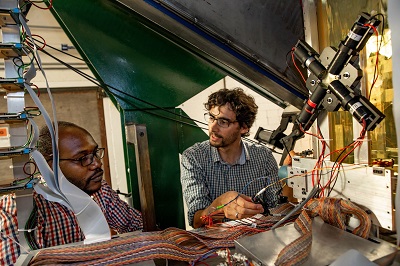Isotope Innovation
 Physics professor Dr. Alfredo Estrade researches unstable isotopes and develops tools to better understand their impact on nuclear physics and astrophysics. Unstable isotopes are atomic nuclei with an unbalanced number of neutrons and protons, and eventually decay into more stable forms. Knowing the properties of unstable isotopes helps understand the nuclear force and nuclear reactions in stars, specifically, those that synthesize new chemical elements.
Physics professor Dr. Alfredo Estrade researches unstable isotopes and develops tools to better understand their impact on nuclear physics and astrophysics. Unstable isotopes are atomic nuclei with an unbalanced number of neutrons and protons, and eventually decay into more stable forms. Knowing the properties of unstable isotopes helps understand the nuclear force and nuclear reactions in stars, specifically, those that synthesize new chemical elements.
To study unstable isotopes, Dr. Estrade and his team of students and colleagues use particle accelerators, machines that accelerate particles to high speeds. Nuclear reactions within the machine send unstable isotopes through a beamline, or a vacuum pipe surrounded by magnets. This allows the team to analyze the isotopes, determine the kind of isotope produced, and measure properties like half-life and mass by using radiation detectors.
The CMU Dow Science Building houses a radiation detector lab where the team develops experimental tools that can be used to analyze isotopes. Their focus is detectors that measure the time particles interact with the beamline. Recently Dr. Estrade’s team developed a detector using plastic scintillators that emit light when hit by an isotope, which is then detected by photomultiplier tubes.
The construction and testing of the detector was the thesis project of Shree Neupane, a CMU Physics graduate student, and tested at the National Superconducting Cyclotron Laboratory at Michigan State University in a measurement led by Kailong Wang. The tests displayed a detector resolution that exceeded the team's design goal of 10 picoseconds or 10 trillionths of a second, with a resolution of 7.5 picoseconds. Their results were reported in an article to the Nuclear Instruments and Methods A. Dr. Estrade and his teams’ success in developing these detectors provided an upgraded set of equipment for future experiments to study unstable isotopes and understand their role in the synthesis of chemical elements found on Earth.
At CMU We Do Research, We Do Real World
Story by ORGS intern Brittney Rudat
May 2021